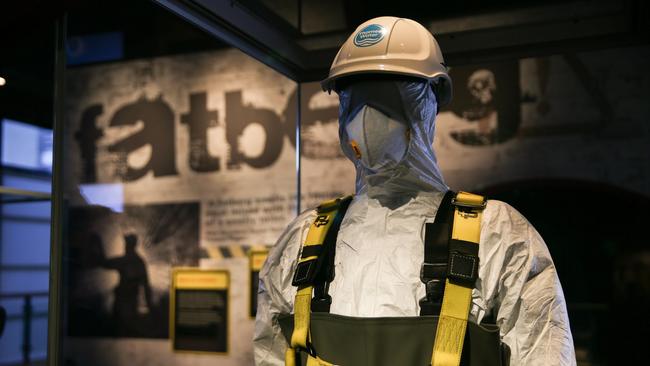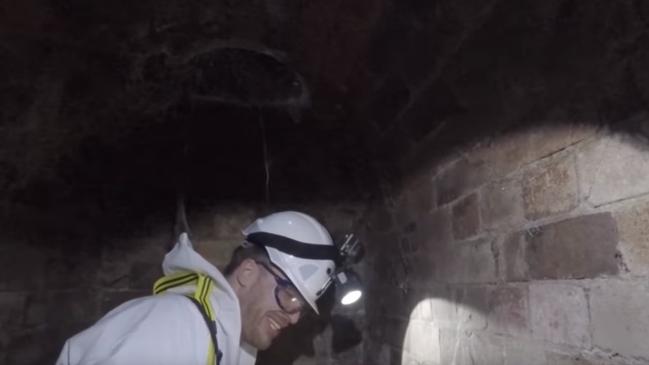What it’s really like to work as a professional ‘fatberg’ fighter
“FLUSHERS” get paid a pittance to stand in sewage surrounded by deadly gases — and break up sewer-dwelling fatbergs by hand.

At Work
Don't miss out on the headlines from At Work. Followed categories will be added to My News.
NOT so deep beneath your feet, an enormous, wormlike monster could be hungrily gobbling up everything you get rid of.
At 750m long, this huge sewer slug sounds like a beast from a horror movie, but it’s not. It’s very real, and it’s called a fatberg.
Fatbergs are the huge globs of hardened gunk clogging the sewers beneath cities around the world, growing larger with every flush.
• The most annoying phrases used at work
• $18 Facebook psychic’s epic fail
Masses of congealed cooking fat stick to wet wipes, condoms, food wrappers and human waste in the sewers beneath us, hardening into a foul-smelling concrete which threatens to block tunnels and flood sewage waste into your home.
The huge brown blobs can grow metres tall and hundreds of metres long, with water providers declaring an epidemic of fatberg emergencies in 23 UK cities, costing tens of millions of dollars to get rid of.
And there’s only one way to wage war against a fatberg: pinch your nose, get down into the sewer, and start chipping away at it by hand.
The brave souls who are employed by Thames Water to fight London’s fatberg epidemic are called “flushers”.
Armed with gas masks, rubber suits and spades, they descend into the darkness of the English capital’s sewer system every night to break up the 12 fatbergs currently clogging London’s arteries.

Each snaking mass of solidified gunk takes weeks to clear, and flushers have to contend with toxic gases, deadly diseases and a torrent of human waste to get at them.
If they fail, sewage pipes will be blocked and, with nowhere else to go, raw waste will start spilling out into people’s homes. They’re all that stands between us and the poopocalypse.
Now, a new documentary shines the light on a team of flushers as they drop into the abyss of London’s sewer system to fight back against the fatbergs.
In Fatberg Autopsy: Secrets Of The Sewer s, cameras follow a team of eight plucky flushers as they butt heads with a 750m-long blockage beneath London’s Southbank.
Fatbergs made headlines last year when one longer than Tower Bridge and weighing the same as 11 double-decker buses was found in London’s sewers, but this one is even bigger — the biggest in the UK, in fact.
And it falls to 21-year-old Adam, nicknamed “Manhole” because of his difficulty lifting the covers, to have the first stab at it.
In full protective gear with goggles and a gas mask on, Manhole looks like he’s about to head into a disaster zone.
But where he’s going is far smellier.
With a camera strapped to his rubber suit, Manhole can only wade slowly through gloopy knee-high sewage, topped with a thick layer of fatty scum.

“We’ve been down worse,” says Phil, an experienced flusher watching Manhole’s camera feed from the comfort of a nearby van.
“We’ll often find fat, oil, grease ... and sweet corn. There’s always a bit of sweet corn in there somewhere. It just holds its form.”
After a few minutes dragging himself through the sludge, Manhole reaches a solid glob of pale-brown fat, metres wide and taller than he is.
There’s only one thing for it: take a shovel to the stinking mound of fat so the smaller chunks can be washed away on the brown current.
As vile as it is, the smell of fat mixed with faeces is the least of the flushers’ worries.
Sewer workers face far greater dangers: diseases can fester in the dark, damp tunnels, and used needles often float past on the scummy water.
Even more deadly are the gases which ooze out of fatbergs, including lethal hydrogen sulphide — a colourless gas which smells of egg and can kill within minutes.
As flushers take their picks to the solidified fat or blast it down with pressure hoses, there’s always the danger that deadly toxins will seep from the cracks into the confined tomblike tunnels.
After two hours of scraping at the glob of fat with his shovel, Manhole’s gas alarm starts beeping, indicating deadly levels of hydrogen sulphide in the air he’s breathing.
He needs to be evacuated from the sewer, but in his hurry to escape from the fumes, he splashes raw human waste into his eye.

It’s just another day in the life of a flusher.
“I’m still not sure how I got into this,” he says, standing by the sewer entrance in the middle of the night. “But here I am.”
With a starting salary of just $31,300 (rising to $55,200 with experience), the appeal of the job may not be immediately obvious.
But there are perks to flushing: Sewer workers have good job security and teams quickly build up a strong sense of camaraderie.
At the end of their mission, the team manages to winch a 16-stone block of fat to the surface, so presenter Rick Edwards can perform the world’s first fatberg autopsy.
Along with mortician Carla Valentine and a team of technicians, Edwards hacks away at the mass of fat to reveal what’s lurking inside.
“It looks like crumbly cheese,” he says, as he holds up a chunk.
Only, it smells far worse and there’s an old condom protruding from it, dangling limply from the side.
When the clump of Britiain’s biggest fatberg is dissected and examined, condoms, live worms, needles, and a mountain of wet wipes are found among the mass.
Acne creams, household soaps, paracetamol and a mass of illegal gym supplements and recreational drugs were also revealed to be in the fatberg’s DNA.
Toxicologist Dr John Wilkinson says on the show: “We’ve found a good number of pharmaceuticals as well as peaks for cocaine and MDMA.
“Anything we put in our bodies is going to end up here.”
Later tests for pathogens reveal antibiotic-resistant strains of bacteria are lurking among the fat.

The superbugs, which could be deadly, are joined in the fetid fatberg by E coli and listeria — bacteria which cause upset stomachs, vomiting and diarrhoea.
If a fatberg blocked a sewage pipe completely, and the torrent of trapped waste ended up seeping into your home instead, these dangerous bugs would emerge with the rising tide.
And the only thing standing between us and a leak is the brave army of flushers who chip away at the fatbergs every night, using shovels, high-pressure hoses and sometimes their own hands to clear the blockages.
So next time you force a wad of baby wipes down the loo or pour your greasy food waste down the sink, beware the monster you could be feeding, and think before you flush.
This story originally appeared on The Sun and was reproduced with permission.
Originally published as What it’s really like to work as a professional ‘fatberg’ fighter


